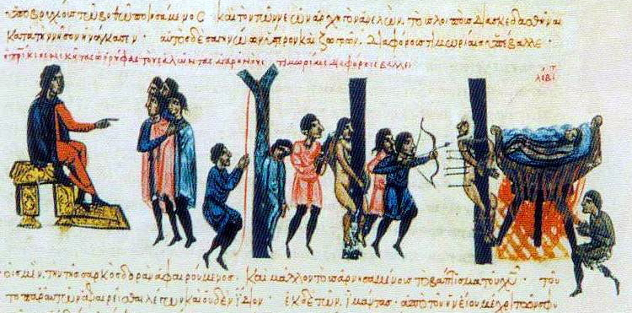Follow us !
10 amazing women who led rebellions - PHOTO
Society
10:00 | 19.12.2013

10 amazing women who led rebellions - PHOTO
Male revolutionaries such as Che Guevara have gone down as heroes for leading rebellions against “the Man.” But forgotten by history are the women who took on far greater powers than Fulgencio Batista. Throughout the ages, women have led rebellions and revolutions which took on the might of the Roman Empire and the vast wealth of the British East India Company.10 Yaa AsantewaaYaa Asantewaa, described as the African Joan of Arc, was Queen Mother of the Edweso region, part of the former Asante Kingdom and now modern-day Ghana. Born around 1830, she was the sister of Kwasi Afrane Panin, who became chief of Edweso when Yaa was young. From the nearby Gold Coast, the British led a campaign of control against the Asante Empire, taxing, converting and taking control of large areas of their tribal land, including gold mines. When the Asante began to resist British rule, the British Governor, Lord Hodgson, demanded that they turn over their Golden Stool, used as a throne and symbol of independence. To enforce his demands, Captain C.H. Armitage was sent to bully the population. Armitage went from village to village, beating children and adults alike in the hopes of obtaining the stool. Eventually, the King of Asante, Nana Osei Agyeman Prempeh I, along with 55 of his chiefs and relatives, were forced into exile. Shortly after, on March 28, 1900, what was left of the monarchy was assembled and the British Captain demanded the Stool. Yaa, the only woman present, gave a famous speech to the British in which she stated that she refused to pay any more of their taxes. She also offered her undergarments in exchange for the loinclothes of any male Asante chief not willing to fight tyrannical Imperial rule. This speech caused the Yaa Asantewaa War for Independence to break out on the same day. As the revolution’s leader, Yaa assembled a personal army of more than 4,000 soldiers. For three months, she was able to lay siege to the British fort at Kumasi. After sustaining casualties in the initial fighting, British reinforcements from Nigeria had to be called in to deal with the troublesome Yaa. Through superior technology, scorched land tactics, and financial rewards for traitors, the Queen Mother was arrested on March 3, 1901. She was sent into exile where she eventually died at 90. 9 Corazon AquinoCorazon “Cory” Aquino was a Filipino woman who, in 1986, led the first democratically elected government of the Philippines since before the Japanese occupation. Born in 1933, she married Benigno “Ninoy” Aquino after graduating from Mount St. Vincent College in New York City. Ninoy Aquino became an outspoken critic of the Philippines dictator, Ferdinand Marcos, who had been in control of the country since 1965. In 1972, Ninoy was arrested by police, imprisoned for eight years and then exiled to the USA. When he was allowed home in 1983, he was assassinated by the government the moment he arrived. This bloody execution, along with an economy in decline, gave Ferdinand’s opposition a boost. Cory, outraged by her husband’s death, took control of the opposition, despite potentially facing the same fate as him. In 1985, a staged election was held to legitimize Marco’s rule. Reluctant to run at first, Cory ran only after receiving a book of one million signatures expressing support for her campaign. During one debate, after being verbally attacked for her gender and political inexperience, Cory gave Marco the metaphorical middle finger by agreeing that she had “no experience in cheating, lying to the public, stealing government money, and killing political opponents.”At the end of the election, in February, 1986, Marco “won” by a landslide. The US Senate and the Catholic Church both accused the dictator of election fraud, and Cory called for peaceful protests, strikes and boycotts. The movement became known as the People Power Revolution—nuns and entire families, including children, took part. In a final attempt to regain control of the population, Marcos ordered the army to fire on the peaceful revolutionaries. The military refused to follow their orders, with many defecting or returning to their bases. By the end of February, the dictator was forced to flee and Corazon Aquino became President of a democratically elected government. 8 Laskarina BouboulinaLaskarina Bouboulina was a Greek naval commander and revolutionary captain who fought in the successful Greek War of Independence against the Ottomans. In May, 1771, Laskarina was born during her mother’s visit to a Constantinople prison. The baby girl was the daughter of a Greek naval captain who had been incarcerated and separated from his pregnant wife during a failed coup against the Ottoman Empire . Upon her father’s death, Laskarina moved with her mother to the island of Spetses. It was here that she married twice, both times into wealthy families. Using the money that she had received from these relationships, she built four ships, including the Agamemnon, one of the largest vessels of the time. Bouboulina became the only female to join the Filiki Etairia, a Greek revolutionary movement planning to oust the Ottomans. On March 13, 1821, 12 days after the group began their War of Independence, Laskarina raised the first revolutionary flag of the conflict over her island home of Spetses. On April 3, Spetses joined the revolution, followed by the islands of Hydra and Psara. Now commanding eight ships, Laskarina joined the blockade of the Ottoman fortress at Nafplion. She later attacked Monemvasia and Pylos, spending almost her entire vast fortune in only the first two years of the ultimately successful war which saw the creation of a Greek state. As Greece became fragmented into factions, Laskarina was twice arrested before being exiled to Spetses. She was later shot in a family dispute. There is no doubt, however, that without her ships, money and command, the revolution might not have been successful. 7 Queen Mavia Of ArabiaMavia was a warrior queen who took on the might of Rome and won. After the death of her husband, al-Hawari, who had no male heir, Mavia became Queen of the Saracens who inhabited southern Palestine and northern Sinai at around A.D. 375. At this time Mavia’s tribe had been all but subjugated by the might of the Eastern Roman Empire.When Roman Emperor Valens requested that Mavia send him mercenary soldiers to fight the Goths, conflict arose over the terms. Revolt broke out as Mavia sought to prove herself competent by taking on the superpower of Rome. The revolt was so fast and effective that it has been compared to the German Blitzkrieg. Cities on the borders of Palestine and Arabia quickly came under attack by her forces. Raids followed by massacres were enacted against Phoenicia, Palestine and even places as far away as Egypt. Roman Provinces were laid to waste and the Roman armies hastily dispatched to deal with Mavia were either worn down or forced to flee. At a monastery in Sinai, the Queen’s armies were able to massacre the monks relatively unopposed. Badly beaten and unable to contain the warrior queen, Emperor Valens was forced to make a peace deal on Mavia’s terms. A local monk of her choice was elected as bishop of the area, giving the tribe far more freedom. Her daughter was also married off to a prominent military official working for Valens, giving Mavia inside access to the Roman administration. 6 Kittur Rani ChennammaKittur Rani Chennamma was an Indian queen who battled the British East India Company. She was born in the small village of Kakati in 1778. From a young age, she rode horses and trained at archery and swordplay. At 15, Chennamma was married to Mallasarja Desai, ruler of Kittur, a small Indian principality. Her husband died in 1816 and their only son died shortly after.Chennamma, now the rightful but unrecognized ruler of Kittur, adopted a son in an attempt to carry on the royal line. However, to seize control of India, the British Government and East India Company enforced the Doctrine of Lapse. This declaration banned native rulers from adopting children if they had none of their own: After —e death of the ruler, their land would become British territory. Not recognizing the adopted child as ruler, the State of Kittur came under the control of the insanely powerful East India Trading Company, under the orders of Mr. Chaplin, commissioner of the region. Rani refused to recognize British rule of her people, and met the British forces as they entered Kittur with an army of her own. Hundreds of British soldiers were killed in the ensuing battle, along with Mr Thackeray, the British-appointed ruler of Kittur. Eventually, far larger Imperial armies from Mysore and Sholapur surrounded the Queen in her fortress. She held the British off for 12 days, until traitors sabotaged her gunpowder supplies. After her defeat, Kittur Rani Chennamma was kept prisoner until she died in 1829. Although unsuccessful, Chennamma acted as a hero and figurehead during the Freedom Movement.5 Leymah GboweeLeymah Gbowee, along with the women of Liberia, organized a peaceful movement which succeeded in bringing an end to a Civil War which had killed more than 250,000 people in 14 years. President Charles Taylor came to power after a bloody revolution which took place from 1980 until 1995. Soon after his election, Taylor began to support ethnic killings and embezzlement. This led to further conflict within the country, with the Second Liberian Civil War beginning in 1999, a war characterized by its brutality and the use of child soldiers.Born in central Liberia in 1972, Leymah quickly became involved in the violence which tore Liberia apart. She trained as a trauma counselor for girls and women raped by militia, also working in the troubled Democratic Republic of Congo. In 2002, Leymah organized the Women of Liberia Mass Action for Peace movement. They gathered women from many different backgrounds to pray and sing in public, demanding peace. Picketing, fasting and threatening a “sex strike,” the women risked their lives, protesting in the capital, to demand that Charles Taylor do something to end the conflict.After pressure from the women and international condemnation, the brutal president finally listened and Taylor flew to neutral Ghana for peace talks. The women followed him to Ghana to continue their efforts. Violence ended in 2003, with Taylor forced to resign and imprisoned by The Hague for crimes against humanity. Democratic elections in 2005 saw Ellen Johnson Sirleaf elected by the people as the first female head of state in an African nation. Leymah Gbowee was awarded the Nobel Peace Prize in 2011. 4 Countess Emilia PlaterCountess Emilia Plater, born to Polish patriots, grew up resenting Russia, which was ruling swathes of Poland and suppressing Polish customs during the 19th century. Born in Wilno on November 13, 1806, Emilia’s parents separated when she was young and her father the Count had little to do with her. She learned to fight from her male cousins, becoming a good fencer. In 1831, news of the Warsaw Insurrection in February, 1830, reached Wilno. Polish patriots in Wilno began planning their own rebellion, not allowing Emilia into their meetings because of her gender. Plater cut her hair and prepared a uniform for herself so that she could join the revolution. At her own expense, she set out and assembled a force of 500 Lithuanian fighters. On March 30, 1831, her army battled a Russian horse patrol. Later, on April 2, she forced an infantry division to retreat. In her greatest feat, Emilia and her group seized the town of Jeziorosy. Later, she joined forces with Karol Zaluski, a revolutionary leading unit of his own. Along with Konstanty Parczewski’s men, Emilia proved herself at the Battles of Kowno and Szawle, earning the rank of Captain in the field. On December 23, 1831, the Countess of the Revolution passed away after becoming fatally ill during the ultimately unsuccessful uprising. 3 Nanny Of The MaroonsNanny, featured on the Jamaican $500 bill, was the leader of a group of slaves who revolted against their British oppressors. Queen Nanny was born into slavery sometime during the 1680s, a child of the Gold Coast, which is now Ghana. At some point Nanny, reportedly of royal blood, was able to escape a British colony on Jamaica and lead a group of slaves into the inner mountainous areas of the island. Soon, large communities of ex-slaves, now calling themselves Maroons, had formed. Nanny Town, founded around 1723, was the first and by far the largest of these communities. From this town, Nanny was able to lead raids against plantations in order to liberate the slaves. However, her revolution quickly captured the attention of the British. A series of campaigns against the troublesome Maroons were launched, and Nanny was forced to lead her people in a guerilla defense operation. To exploit the defensiveness nature of inland Jamaica, Nanny ensured that Maroon settlements were built high into the mountains. Often, they had only a single approach, meaning that attacking British soldiers were easily picked off by small numbers of Maroons, to whom Nanny had taught the art of camouflage. Nanny Town itself was attacked on a number of occasions, in 1730, 1731, 1732, and several times in 1734. One British attack in 1734 succeeded in capturing the settlement, which forced Nanny and the survivors to flee and found a new camp, from which they proved just as defiant. Some historians suggest that Nanny was trained in the art of catching bullets with her hands. Whilst others, mainly the British, seeking to discredit Nanny, claim she caught bullets with her buttocks and farted them back out. Although Nanny and her people faced nearly constant attack and hunger, they remained united and strong against the British under her rule. From 1739–40, the British signed a peace treaty with the Maroons, giving them 500 acres of land to call their own. Nanny, a Jamaican national hero, is credited with preserving the culture and freedom of her people and being a powerful symbol of the resistance to slavery. 2 ToypurinaToypurina was a Native American medicine woman who opposed Spanish colonization of her tribal lands. In 1771, when the Spanish first appeared, Toypurina was a 10-year-old girl and witnessed first-hand the suffering that her people, the Kizh Nation, faced at the hands of the Spaniards. In one instance, after the colonists had claimed land to build San Gabriel Arcangel Mission, the wife of a local chief was raped by the mission soldiers. When the chief protested, he was killed and his head stuck on a pike as an example. After the mission’s construction, Toypurina witnessed over 1000 Native Americans lured into its walls. All were bribed or forced to convert to Christianity. These converts were confined to the mission and were often used as forced farm labor. As Toypurina grew up, she became an influential medicine woman and shaman. In 1785, an indigenous member of the mission, Nicolas Jose, contacted Toypurina. Jose was angry about the mission ban on traditional dancing. Together, they plotted to lead a rebellion against the Spanish. They were joined by Toypurina’s brother, a Kizh Nation chief, and warriors from eight villages she had convinced to join them in arms. To even have a chance against the muskets and artillery of the Spanish, Toypurina planned to kill the leaders of the Spanish Church with magic, allowing native warriors to easily overwhelm the defending force. Scaling the wall with dozens of warriors on a moonless night, the raiding party rushed into the priests’ rooms. Two figures on the ground laid motionless, as if the shaman’s magic had worked. Suddenly, the bodies rose up—the two dead priests were actually Spanish soldiers in disguise, who let out a yell for reinforcements. In seconds, the Native American rebels were surrounded. The Spanish had been tipped off about the raid and it turns out magic is not a very effective weapon. Two months later, when the rebel leaders were put on trial, they turned on Toypurina, saying that she was a witch who had controlled them. Toypurina used the trial to tell her people to fight the white men who trespass on their land and despoil their traditions, and not be afraid of “Spanish sticks that spit fire.” Toypurina was sentenced to exile and possibly forced baptism in a Spanish mission, where she spent the rest of her life. 1 Margarita NeriThe Mexican Revolution began on November 20, 1910, and raged well into the 1920s. It was an attempt by revolutionaries to overthrow the ruler and dictator Porfirio Diaz Mori and implement a constitution, which would aim to ensure fairer life for the farming classes. The conflict was bloody, with around 900,000 people losing their lives. Such vast death and destruction meant that both sides were more than willing to involve women and children in combat.One army of 5,369 revolutionaries inspected by US officials included 1,256 women and 554 children. Whilst the children mostly foraged and cooked, the women were usually armed and fought alongside the men. Despite facing constant inequality and sexism, women were still willing to play a major role in Mori’s eventual downfall. Those female soldiers that the revolutionary side brought into action were called soldaderas. Perhaps the most famous of all the soldaderas was Margarita Neri, who not only fought in the war, but also acted as a commander. A Dutch-Maya from Quintana Roo, from 1910, she commanded a force of over 1000 which swept through Tabasco and Chiapas, looting, burning and killing. Neri was so effective in her slaughter of anti-revolutionary troops that the Governor of Guerrero hid in a crate and fled the town upon hearing of her approach. Whether Margarita fought for the revolution directly, under Francisco Madero’s command, or whether her unit worked independently remains unclear. However, what is clear as day is that she and her soldiers were a serious threat to the Government, with Neri vowing to decapitate Diaz herself.(http://listverse.com/)ANN.Az










